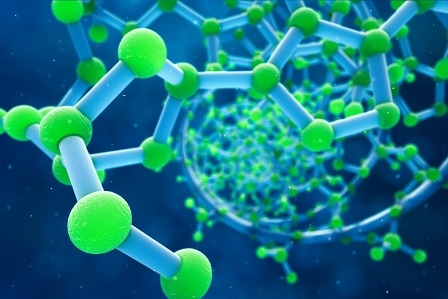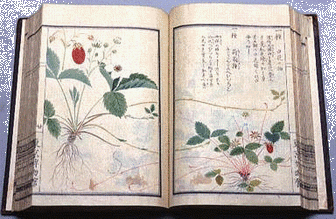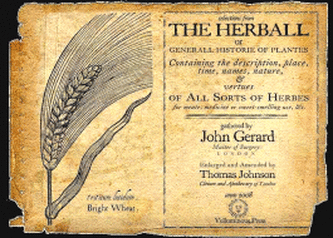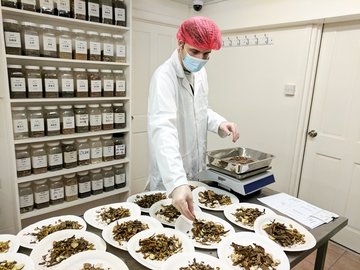Herbal Medicine - a diversity of traditions with a common aim
Herbal medicine is practised within a variety of traditional medicine including:
All these traditions use herbal medicines extracted from seeds, berries, roots, leaves, bark and flowers for the treatment of disease and the maintenance of good health. Each tradition has developed its own diagnostic framework which needs intense study and clinical training. Herbal medicine should not be confused with homeopathy: they are entirely different systems of medicine. Homeopathy normally uses extremely dilute dosages of many different substances which may include plants.
- Ayurveda
- Chinese Herbal Medicine (part of traditional Chinese medicine)
- Traditional Tibetan Medicine
- Unani Tibb
- Western Herbal Medicine (AKA Phytotherapy)
All these traditions use herbal medicines extracted from seeds, berries, roots, leaves, bark and flowers for the treatment of disease and the maintenance of good health. Each tradition has developed its own diagnostic framework which needs intense study and clinical training. Herbal medicine should not be confused with homeopathy: they are entirely different systems of medicine. Homeopathy normally uses extremely dilute dosages of many different substances which may include plants.
Herbal medicines – green power to optimum health
Human beings (Homo sapiens) evolved some 200,000 years ago. Over this time human physiology has adapted to benefit from a plant-based diet rich in compounds and nutrients (phytochemicals) naturally present in fruits, grains, nuts, seeds, vegetables and other plant foods. Herbal medicines have been used by humans since the dawn of history too and over millennia our systems have similarly become well adapted to them. Evidence suggests that consuming foods high in phytochemicals reduces the risk of contracting illnesses as well as helping to alleviate many chronic diseases including cardiovascular disease, cancer, Alzheimer’s disease and type 2 diabetes as well as playing a vital role in healthy aging.[1],[2] It is for this reason that diets like the Mediterranean and Palaeolithic diets, rich in these phytochemicals, are thought to be so beneficial for health.[3]
Human beings (Homo sapiens) evolved some 200,000 years ago. Over this time human physiology has adapted to benefit from a plant-based diet rich in compounds and nutrients (phytochemicals) naturally present in fruits, grains, nuts, seeds, vegetables and other plant foods. Herbal medicines have been used by humans since the dawn of history too and over millennia our systems have similarly become well adapted to them. Evidence suggests that consuming foods high in phytochemicals reduces the risk of contracting illnesses as well as helping to alleviate many chronic diseases including cardiovascular disease, cancer, Alzheimer’s disease and type 2 diabetes as well as playing a vital role in healthy aging.[1],[2] It is for this reason that diets like the Mediterranean and Palaeolithic diets, rich in these phytochemicals, are thought to be so beneficial for health.[3]

Synergy
Herbal medicines operate via these same compounds e.g. polyphenols, saponins, alkaloids, tannins, essential oils, fatty acids, vitamins and trace elements. The orchestra of chemical compounds naturally present in plant medicines act in concert to make active constituents safely and easily available. This is why herbal medicines are ideal tools to restore health and treat disease. The therapeutic effect of the whole plant tends to be significantly more effective than the particular action of any of its known constituents. In this context, two and two turns out to add up to rather more than four. Using this synergetic principle, herbal practitioners customarily combine herbs together to take further advantage of the subtle but potent healing potential of mixtures of traditional herbal medicines.
Herbal medicines operate via these same compounds e.g. polyphenols, saponins, alkaloids, tannins, essential oils, fatty acids, vitamins and trace elements. The orchestra of chemical compounds naturally present in plant medicines act in concert to make active constituents safely and easily available. This is why herbal medicines are ideal tools to restore health and treat disease. The therapeutic effect of the whole plant tends to be significantly more effective than the particular action of any of its known constituents. In this context, two and two turns out to add up to rather more than four. Using this synergetic principle, herbal practitioners customarily combine herbs together to take further advantage of the subtle but potent healing potential of mixtures of traditional herbal medicines.

Herbal medicine – a brief history
Plants have been used as medicines before recorded history and their medicinal use is common to all cultures and peoples of the world. The Chinese Shen Nong Ben Cao (Divine Farmer’s Materia Medica) was attributed to the mythical Chinese emperor, Shen Nong, reputedly a skilled herbalist who, legend says, lived some three thousand years BCE. In reality, this ancient medical text dates back to the first century BCE. The ancient Egyptian Ebers Papyrus, written circa 1550 BCE contains references to more than 700 herbal remedies. The Charaka Samhita is the oldest extant treatise on Ayurveda thought to have been compiled in the 1st century CE. The original lost text was written several centuries earlier around 600 BCE.
Plants have been used as medicines before recorded history and their medicinal use is common to all cultures and peoples of the world. The Chinese Shen Nong Ben Cao (Divine Farmer’s Materia Medica) was attributed to the mythical Chinese emperor, Shen Nong, reputedly a skilled herbalist who, legend says, lived some three thousand years BCE. In reality, this ancient medical text dates back to the first century BCE. The ancient Egyptian Ebers Papyrus, written circa 1550 BCE contains references to more than 700 herbal remedies. The Charaka Samhita is the oldest extant treatise on Ayurveda thought to have been compiled in the 1st century CE. The original lost text was written several centuries earlier around 600 BCE.

Over the centuries, the medicinal use of herbal medicines was tried and tested empirically and then recorded in many famous herbals - such as those of the English herbalists Gerard and Culpeper as well as those of India, China and Tibet - published through the centuries. Much of this priceless knowledge is now disregarded by modern medicine; nowadays plants are generally only valued by the pharmaceutical industry for their perceived ‘actives’ and the remaining ‘inert’ constituents are discarded. In this way, drug companies isolate and extract an active principal which can be purified and patented. The discovery and isolation of active plant compounds that gave birth to modern drug discovery and development only began in the 19th century. Despite the current preoccupation with synthetic chemistry as a vehicle to discover and manufacture drugs, the contribution of plants to disease treatment and prevention is still vast. At the start of 21st century, 11% of the 252 drugs considered as basic and essential by the WHO were exclusively of flowering plant origin.[4] Researchers noted that 80% of 122 plant derived drugs had a traditional medicine use identical or related to the current use by the pharmaceutical sector of the active elements of the plant.[5] . Some 120 well-known licensed medicines were originally derived from plant sources - e.g. aspirin from willow, steroids from the Mexican yam, digoxin from foxglove, theophylline from tea, morphine from the opium poppy etc.[6] Herbalists choose to use whole plant medicines which they see as a more natural way to secure good health and treat disease.
Modern scientific research confirms a wide spectrum of these traditional herbal uses e.g. St John’s wort for depression, hawthorn for circulatory disorders and valerian to aid sleep. Traditional use is now accepted as the basis of herbal registration for over-the-counter herbal products throughout Europe via the Traditional Herbal Medicinal Products Directive (2004/24/EC).
Modern scientific research confirms a wide spectrum of these traditional herbal uses e.g. St John’s wort for depression, hawthorn for circulatory disorders and valerian to aid sleep. Traditional use is now accepted as the basis of herbal registration for over-the-counter herbal products throughout Europe via the Traditional Herbal Medicinal Products Directive (2004/24/EC).

Growing, manufacturing and dispensing herbal extracts and medicines
Some herbalists grow and collect plant material to make their own medicines, and most prepare and dispense their own remedies. This involves running and maintaining dispensaries and thus skills in stock and quality control, health and safety and hygiene are essential, as of course are an in depth knowledge of plant identification, and an understanding of cultivation methods, harvesting and conservation.
Traditionally infusions (teas) or decoctions (boiled-up herbs) have been used and many herbalists still recommend their use. Tinctures are widely used by Western herbalists and are a convenient easy-to-take concentrated liquid. Powdered herbs in the form of ground-up herbs or concentrated extracts are also often used especially by Chinese herbal practitioners and are another convenient way to take herbs either mixed with water or in capsules. European regulations mean that manufactured herbal medicines such as tablets can only be sold if they are licensed with a “Traditional Herbal Registration” or have marketing authorisation to be used as a medicine. For minor self-limiting conditions that people can safely treat themselves, such as coughs and colds, headaches, hayfever, indigestion or muscular pain, herbal medicines that can be bought over-the-counter (OTC) are a good choice for self care.[7]
Some herbalists grow and collect plant material to make their own medicines, and most prepare and dispense their own remedies. This involves running and maintaining dispensaries and thus skills in stock and quality control, health and safety and hygiene are essential, as of course are an in depth knowledge of plant identification, and an understanding of cultivation methods, harvesting and conservation.
Traditionally infusions (teas) or decoctions (boiled-up herbs) have been used and many herbalists still recommend their use. Tinctures are widely used by Western herbalists and are a convenient easy-to-take concentrated liquid. Powdered herbs in the form of ground-up herbs or concentrated extracts are also often used especially by Chinese herbal practitioners and are another convenient way to take herbs either mixed with water or in capsules. European regulations mean that manufactured herbal medicines such as tablets can only be sold if they are licensed with a “Traditional Herbal Registration” or have marketing authorisation to be used as a medicine. For minor self-limiting conditions that people can safely treat themselves, such as coughs and colds, headaches, hayfever, indigestion or muscular pain, herbal medicines that can be bought over-the-counter (OTC) are a good choice for self care.[7]
[1] Murugaiyah V, Mattson MP. Neurohormetic phytochemicals: An evolutionary-bioenergetic perspective. Neurochem Int. 2015 Oct;89:271-80.
[2] Howes MJ, Simmonds MS. The role of phytochemicals as micronutrients in health and disease. Curr Opin Clin Nutr Metab Care. 2014 Nov;17(6):558-66.
[3] Whalen KA, McCullough ML, Flanders WD, Hartman TJ, Judd S, Bostick RM. Paleolithic and Mediterranean Diet Pattern Scores Are Inversely Associated with Biomarkers of Inflammation and Oxidative Balance in Adults. J Nutr. 2016 Jun;146(6):1217-26.
[4] Veeresham C. Natural products derived from plants as a source of drugs. J Adv Pharm Technol Res. 2012 Oct;3(4):200-1.
[5] Fabricant D S, Farnsworth N R. The value of plants used in traditional medicine for drug discovery.Environ Health Perspect. 2001 Mar; 109(Suppl 1): 69–75.
[6] Taylor L. Plant-based drugs and medicines. http://www.rain-tree.com/plantdrugs.htm#.V4KAkxLJlHo. Accessed 10/7/16
[7] Over-the-counter herbal products are widely available from health food shops, pharmacies, supermarkets and from some online suppliers. To ensure that the product has strict quality controls in place, though, look for a registration number on the pack (either ‘THR” (Traditional Herbal Registration) or “PL” (Product License) followed by a series of numbers/letters. The British Herbal Medicine Association has members whose products meet the required quality standards and these products will contain clear, officially approved information on their safe use. See www.bhma.info for more details.
[2] Howes MJ, Simmonds MS. The role of phytochemicals as micronutrients in health and disease. Curr Opin Clin Nutr Metab Care. 2014 Nov;17(6):558-66.
[3] Whalen KA, McCullough ML, Flanders WD, Hartman TJ, Judd S, Bostick RM. Paleolithic and Mediterranean Diet Pattern Scores Are Inversely Associated with Biomarkers of Inflammation and Oxidative Balance in Adults. J Nutr. 2016 Jun;146(6):1217-26.
[4] Veeresham C. Natural products derived from plants as a source of drugs. J Adv Pharm Technol Res. 2012 Oct;3(4):200-1.
[5] Fabricant D S, Farnsworth N R. The value of plants used in traditional medicine for drug discovery.Environ Health Perspect. 2001 Mar; 109(Suppl 1): 69–75.
[6] Taylor L. Plant-based drugs and medicines. http://www.rain-tree.com/plantdrugs.htm#.V4KAkxLJlHo. Accessed 10/7/16
[7] Over-the-counter herbal products are widely available from health food shops, pharmacies, supermarkets and from some online suppliers. To ensure that the product has strict quality controls in place, though, look for a registration number on the pack (either ‘THR” (Traditional Herbal Registration) or “PL” (Product License) followed by a series of numbers/letters. The British Herbal Medicine Association has members whose products meet the required quality standards and these products will contain clear, officially approved information on their safe use. See www.bhma.info for more details.